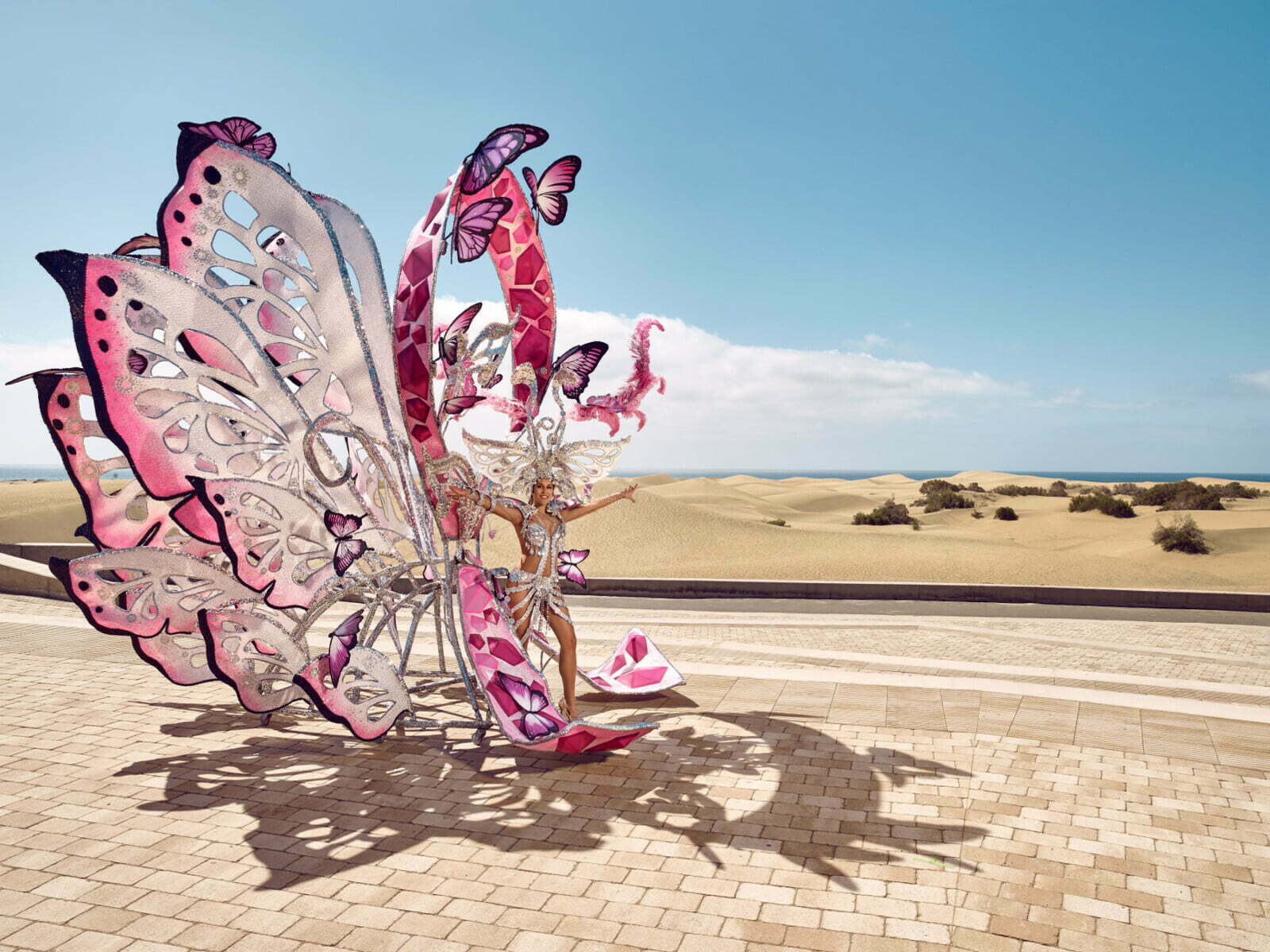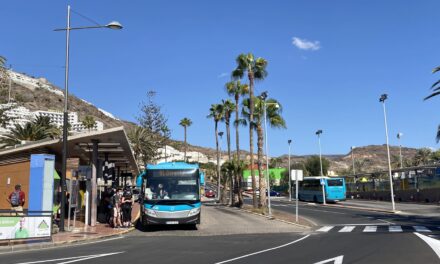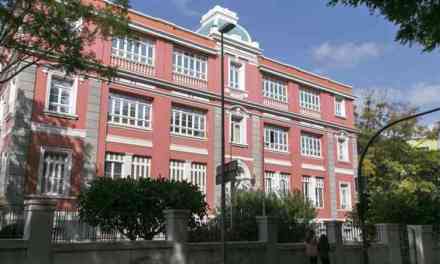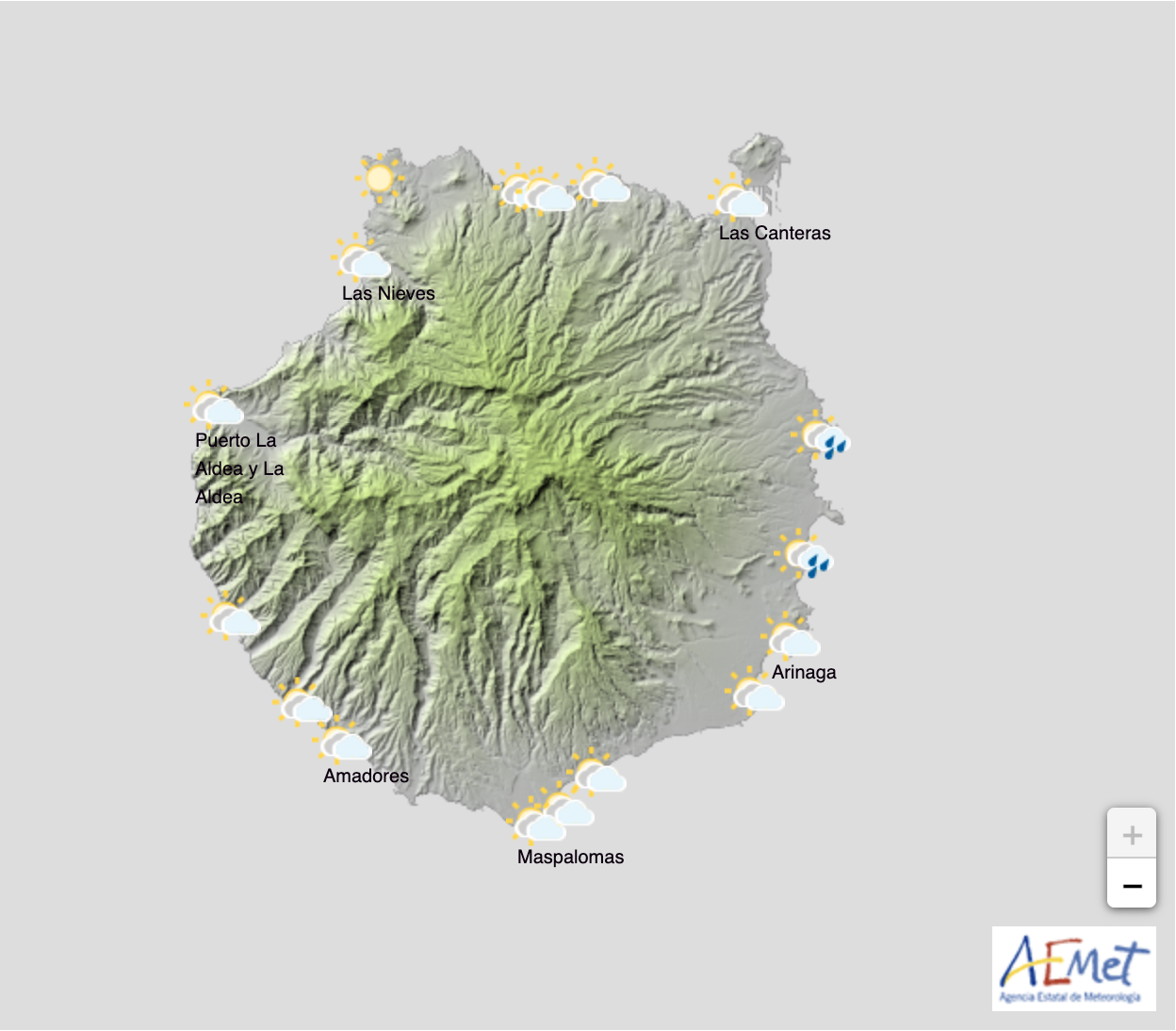One of the more interesting legacies, promoted through Gran Canaria’s near 500 year old tradition of Carnaval, has got to be the outlandish displays of public cross-dressing, these days celebrated as mass media events with a full system of lights, pyrotechnics and massive sound, but they were once upon a time more hidden away in rural communities. It is one of the most transgressive acts of annual trespass to be found in this sub-tropical archipelago. Carnival arrived here with the Genoese merchants, and the pioneering sugar planters who, alongside the catholic church, funded the Spanish conquest of these islands in the late 15th century. By the 16th century it was already an annual fixture in the Ciudad Real de Las Tres Palmas, later known as Las Palmas de Gran Canaria. It established itself on Tenerife, and spread across the islands.
Of course, this tradition has much more ancient roots in the closing acts of winter. When waning meat and dairy supplies might be ceremonially feasted upon, en masse, often in great public gatherings, all across medieval Europe and throughout christendom, as entire communities, large or small, ritually braced themselves for a potentially lean forty days and forty nights, in the run up to the first green shoots of Spring and then Easter. It’s where we get pancake day, or shrove Tuesday. Some celebrate it as Mardi Gras. Here we head out into the sunshine for Carnival and party all night long.
In large part, these annual celebrations of flesh, these Carnevale, to ceremonially empty the winter stores, were presided over, often, by those men, who wore dresses, in very high places. They would include excessive drinking, often the last of the summer wine, and whatever other ales or spirits might be mustered, in what easily turned into Bacchanalian debauches. These ceremonies offered the peasantry, and the nobility alike, masqued anonymity, a great levelling, and tacit permission for days, or in some cases even weeks, of sinful excesses to the extreme. Every last drop of liquor could be drunk, and every last morsel of food be devoured, and sometimes no pleasure denied, as a means, perhaps, to help mentally prepare those rough-handed masses for any inevitable scarcity that might otherwise disrupt them from their fields, and preparations for the spring and the summer ahead. Transgression, and sin, may often lead to a sense of humility, and help focus the mind on the heavy work ahead, or so the thinking goes. It became a time to let off steam, to step outside of your normal self and act without concern, celebrate wildly and behave in ways normally not acceptable.
On The Canary Islands, once all has been consumed in the merry-making moment of collective madness, forgiveness can once again be found in the final “Funeral of the Sardine”, a cremation pyre on which the glittering embodiment of every breach and drunken misdeed of the preceding days, each delinquent sin, can be ceremonially purified in one final symbolic act of redemption and a return to piety. Though, on occasion, that sinful Sardine is rescued, resuscitated, and revived, for one further continuation of the debauchery in hand, as the fiestas move around the islands… only to be ritually cremated once more, when all is said and done.
Cross-Dressers in the fields
During Spain’s 40 years of dictatorship, Carnival was banned on these islands, but not so easily suppressed. Testimony to the Canarian love for this much-adored, and then forbidden, annual pleasure, can be found in the old town square of Agüimes, on the inland east of Gran Canaria, originally the seat for the Bishopric of these islands. Lands taken from an aboriginal population and gifted, along with its peoples, to the catholic church who had supplied so much of the money required to send ship after ship filled with armed men over the 16 years or more it took to finally subdue the natives of this archipelago, after nearly 100 years of trying. There, on the other side of the old Plaza del Rosario, gazing playfully at the majestic church facade, is Ana Luisa Benítez’s homage to two farming peasants of the town, he with hands on hips, and she with one hand thrown playfully into the air.
Were you, however, to approach this traditional-looking “campesino” couple you might just notice something rather odd. The fellow, diminutive in stature, wears clothes that appear much too big for him, and a carnival mask, behind his head hair tied in a bun; and the “lady” by his side, is rather taller and thicker set than expected, sporting a big bushy moustache and a mask of her own. They are in fact dedicated to the cross-dressing peasantry of rural communities like Agüimes, where these transgressions continued even through the years when they were most threatened by the authorities, in secret carnivalesque events, where many of the men dressed as women, and the women dressed as men.
It was subversive, and exciting, and not too easy to spot a face you may know, should a passing Guardia Civil patrol happen to disrupt proceedings, sending giggling villagers running into the night and through the fields, unrecognisable in their granny’s bonnet and shawl, or their husband’s hat and britches.
Other rural communities too would celebrate with dinner events, and the tomato harvesting community of El Tablero, on the south of Gran Canaria, were known to have secret “winter” balls, where some guests would be dressed in clothes other than their own, that over time started to evolve back towards the more traditionally celebrated pre-lenten festivals.
Winter Fiesta Maspalomas
Cross-dressing and raucous fiesta has long been at home in the carnival celebrations of the Canary Islands. As Spain slowly emerged towards democracy, in 1974, Maspalomas was the very first to return to traditional ways, with the “Fiestas de Invierno” winter festival, which encouraged outdoor partying in colourful clothes around the first shopping centre in the south, the Kasbah centro comercial, next to the ecumenical church. This lit a beacon for the rest of the island, with carnival groups forming in the capital city neighbourhoods of La Isleta, beginning to tentatively head out on to the streets to party, with fresh honey poured into their rum.
By 1983 Maspalomas International Carnival had been officially born, making more of a show for the visitors of the traditional celebrations, with events like the “Rescue of the Sardine” which, to this day, bewilders tourists between the beaches of Maspalomas and Playa del Inglés, and setting the main stage in the newly opened Yumbo Centre, 40 years old this year, in the heart of what was at the time the one of the busiest resorts in Spain.
Miss Traveskarnatival Drag Gala

Carmen Franco Hierro, wife of then deputy mayor Antonio Martín Falcón, presenting the award to the first Miss Traveskarnatival, Yaiza Rodríguez, La Minga in 1986. The organisation had to resort to councillors’ wives to deliver the bouquets. Image courtesy of Pedro Franco
A chap called Pedro Franco served on the Carnival Commission that had by then been set up by the Illustrious Town Hall of San Bartolomé de Tirajana, to organise these annual events, “We had been observing for several years that some transvestites used to put on impressive costumes to participate in the burial of the Sardine, and we wondered why not put them on stage?”
They caused a sensation, with a new event called “Miss Traveskarnatival” in 1986, which laid all the transgressive foundations for the modern Drag Galas that we see today. At the time, writes Gaumet Florido, of Spanish language daily Canarias7, it wasn’t an easy sell.

Fidel “Funny Boys” Rodriguez and Ana Lúpez host one of the first Yumbo “Miss Travekarnatival” Galas in Maspalomas, the progenitor to the Carnival Drag Galas on Gran Canaria and across the islands.
It was even difficult to find presenters for the event, (one of the very first presenters was Ana Lupéz, recipient of Spain’s first legal gender reassignment surgery, alongside the infamous local cabaret entrepreneur, Fidel “FunnyBoys” Rodriguéz, who to this day continues to delight audiences in the Yumbo) and for the awards ceremony, they had to resort to the wives of the unwilling town councillors to make the presentations. “The media here barely covered it, but it was very well received in European newspapers,” Franco recalls.
You can read more on this subject and much of our recent local history in Pedro Franco’s extraordinary memoirs of Maspalomas, on his blog El Miano de Maspalomas
The first officially named “Drag Gala” on the island, was held in Las Palmas de Gran Canaria in 1998. The Miss Traveskarnatival, a mixing of the spanish words for Transvestite + Carnival, held in Maspalomas, at the Yumbo, was its most likely inspiration. Maspalomas Carnival is now being recognised as the crucible in which the world famous Drag Galas on Gran Canaria were first conceived, and a new documentary will soon tell the story, produced by Audiotec and promoted by the Canary Islands General Directorate of Diversity coordinated by Víctor Rodríguez.
The Chiringays
From the carnival celebrations, among the cafés and terraces of the Parque Santa Catalina, in Las Palmas de Gran Canaria, the Gamá collective was formed when two groups combined with the activism of a Christian LGTB group, who would meet there in the early 1990s and participate ever more visibly in carnival celebrations. At that time Santa Catalina Park, and the Port area, already hosted an array of well-known bars and clubs with provocative names like WHY NOT, PUB MIAU, FLASH nightclub and INOLVIDABLE (UNFORGETTABLE). It was the local business community of gay and Gamá collective venues, together with the year 2000’s artistic directors of the Carnival, who proposed the creation of what were to become known as the Chiringays.
“We told them how interesting it could be for gay locals to invigorate carnival with their own area. It could be a focus of interest to give visibility, and at the time of the first big demonstrations, the gay scene and activism began to carry a lot of weight”, recalls the current artistic director of the Las Palmas de Gran Canaria carnival, Israel Reyes, in an interview with CanariasAhora, in 2020.
The first edition of the “Chiringays” was in the Lolita Pluma area, and was a success. About six stands were carefully decorated with the motifs of each nightlife venue; the following year there were eight and the year after that they practically could not fit into Santa Catalina. The fiesta ended at 5 in the morning, when they would cut off the music, and continued in the clubs until dawn.
Lolita Pluma was well known in Parque Santa Catalina, due to her extravagant attire and makeup, and the fact that she was surrounded by all the park’s cats, which she fed. She sold paper flowers there, chewing gum and postcards to tourists. She was named Queen of Santa Catalina Park in 1984. There is a statue in her honour there to this day.
“There was a great atmosphere in those years. We had a great time, people had a safe place to be visible on the street. It was a diverse and joyful space where LGBT people met with their people. There was such good vibes that all kinds of people came to our area, even fleeing the outbreak of fights in the bars of Parque Blanco”, says Montserrat González, president of Gamá.
The Chiringays became a friendly space and a nostalgic meeting point for music lovers of the 80s and 90s, and above all in an area where everyone enjoyed the carnival in a diverse environment: “It created a very good vibe and it became a space for fun hand in hand with diversity, respect, tolerance and freedom of expression”.
The Drag Gala had been held for two years, by that point, and had become the LGBT visibility event par excellence. “It coincides with the rise of the LGTB movement and the demonstrations, the [chiringuito] beach bars, the Drag Gala and Gamá delivered a social shock, with a lot of presence. One thing supported the other,” says Reyes. The chiringuitos became a space where the LGBT community organised itself for the fiesta, the Drag Gala was the visibility showcase of tolerance and Gamá as the activist reference, already well-positioned after several Pride celebrations in the capital.
“That’s why Gamá has always been very active in the carnival, it was and is a great showcase to continue educating,” says Reyes as he remembers, with a smile, how during those years, as the staff of the LGTB collective distributed condoms on the street, there were still some politicians who blushed.
“There is still a conscience to educate, to raise awareness about sexually transmitted infections (STIs), HIV and the social commitment not to lose one’s head at carnival. Gamá has always been a reference and it is very important that it continues to be in the quintessential gay-friendly area of our carnival” Reyes emphasises.


















